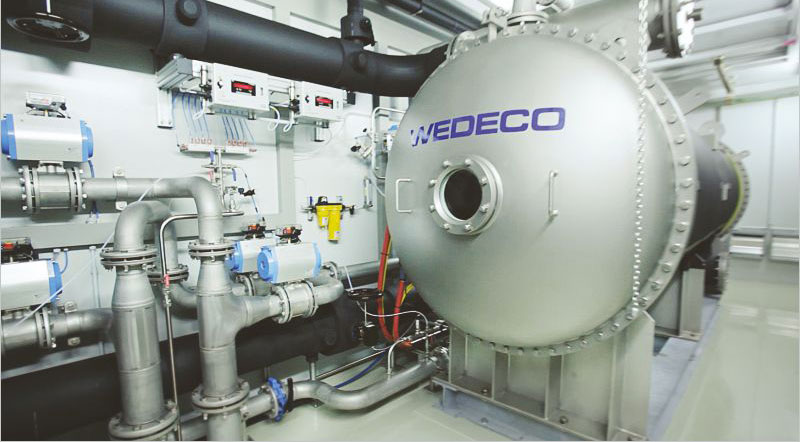With products sold in more than 150 countries, Xylem’s brands have served the water market for many decades. Its brands serve a number of industries including pulp and paper, agricultural, construction, environmental, food and beverage, government agencies, industrial, public utilities, residential and commercial building services. In the pulp and paper industry, Xylem is famous for its ozone plants helping to reduce pulp production costs, water usage and effluent discharge, Mr. Alexis Metais, Pulp & Paper Key Account Manager at Xylem, shares with Paper Mart.

Paper Mart: Please take us through the major solutions you cater to enhance water efficiency of pulp and paper mills in India.
Alexis Metais: In the pulp and paper industry, Xylem is famous for its ozone plants helping to reduce pulp production costs, water usage and effluent discharge. Z-ECF pulp bleaching (ie ECF bleaching with an ozone step) results in better pulp quality, high brightness ceiling, lower brightness reversion, lower operating costs and lower bleach plant effluent discharge (in volume but also in COD and color loads) when compared to conventional ECF bleaching. Our ozone systems are also used to treat NOx in the flue gas and replace biocide in treatment of cooling water. Our UV (ultraviolet) systems are also widely used in paper mills to treat paper machine white water and reduce biocide costs and environmental impact. But we can offer much more: Xylem is a leading water technology provider supporting pulp and paper mills with pumping, treatment and metering solutions for both intake water and effluent. It is our core business where we offer a very large portfolio of solutions and extensive expertise based on experience. Together with our partners, we can develop the best fitting solutions with lab and pilot trials for the most complex situations. Our technologies help to reduce color, TSS and COD in ETPs (Effluent Treatment Plants) and meet the strictest environmental discharge norms.
PM: Discuss how your innovations have helped mills reduce their water footprint.
AM: Research in ozone generation and pulp bleaching chemistry made pulp bleaching with ozone more competitive, efficient and reliable and led to reduced water footprint. Indeed, filtrates of standard ECF bleaching contain chlorides. These ions are highly corrosive and shall not reach the recovery boiler in significant amounts. Alternative is to bleach without any chlorine-based chemical or very little in the first bleaching stage. It has been done since the 1990s with ozone, either in a stand-alone Z-stage or in combination with a small chlorine dioxide shot in Z/D without intermediate washing. Filtrates from the following extraction stage can then be used in the post-oxygen washer if the pulp mill faces any need to lower its effluent discharge.
Watch: Top Paper Companies 2023
PM: Who are your clients? What factors do you usually identify before collaborating with them?
AM: Our clients were initially pulp mills specifically caring about their environmental impacts and with an innovative mindset. Today economics are also a driver as ozone bleaching proved to bring several benefits not limited to improved effluent parameters. It is then possible to combine two targets that are often seen as opposed but, in fact, are not: environmental footprint and profits. We collaborate with every kind of pulp and paper mills, from small ones up to some producing more than a million tons of pulp per year. As you know, every project takes time in our industry where we count in years and not in weeks. It makes every collaboration a chance to build strong and rich relationships, going far beyond professional exchanges.
Our UV (ultraviolet) systems are also widely used in paper mills to treat paper machine white water and reduce biocide costs and environmental impact.
PM: What is the most distinguished collaboration you have ever done? Kindly elaborate the process, and what made it successful.
AM: In India, our most distinguished collaboration has been with ITC in the Bhadrachalam mill. In 2008, ITC installed ozone bleaching in its existing fiberline and a second new bleach plant. Both lines were fed with a single ozone generator supplied by us. It is a clear example of the high reliability of the Xylem technology: no redundancy is needed. The ITC project was the trigger for Xylem to establish in India a service team dedicated to ozone, supporting the commissioning and maintenance of our numerous customers in different industries and water treatment plants. After 15 years of operation, ITC recently replaced its 2 bleach plants with a new Single Bleaching Line, again with ozone. It is our target and great success to serve satisfied clients.
PM: What new innovations are you going to launch, and what impacts will they create?
AM: Our innovation continuously looks at 2 directions, ozone generation and pulp bleaching. By improving our technology, we reduce the cost of ozone and consequently production costs of pulp, making the green bleaching case stronger. Small incremental changes are not always noticed. But ozone costs will continue to lower year after year. Specifically for India, we’re looking at alternative solutions to improve the payback of ozone bleaching in the case of small agro-pulp mills. Impact could be big on the water footprint if converting to ozone bleaching the numerous mills still using elemental chlorine and some operating with chlorine dioxide.
Besides that, two giant water technology market leaders Xylem and Evoqua are one now. Together, we bring uniquely powerful capabilities to solving the world’s greatest water challenges. Uniting our complementary approaches, products and expertise, we enable our customers to dramatically improve the way water and wastewater is used, managed, conserved, re-used and returned to nature.
Also Read: Krofta: Harnessing the Power of Wastewater
PM: How water efficient will the mills become in the next five years, and where do you see yourself in this?
AM: Mills will become more and more water efficient, better closing the loops and treating recovered water. As explained earlier, ozone bleaching allows for recirculating the filtrates in place of discharging them. But recovering water means also treating it. We offer a wide range of solutions with ozone, UV, filtration and specific products for complex cases, from smarter aeration to advanced filtration and chemical-free disinfection. Considering the drive of Indian pulp and paper companies for environmental solutions, our Xylem portfolio as well as the reach and expertise of our Indian colleagues, I strongly believe the next 5 years will bring successful collaborations between Xylem & the Indian pulp & paper industry to solve water.




